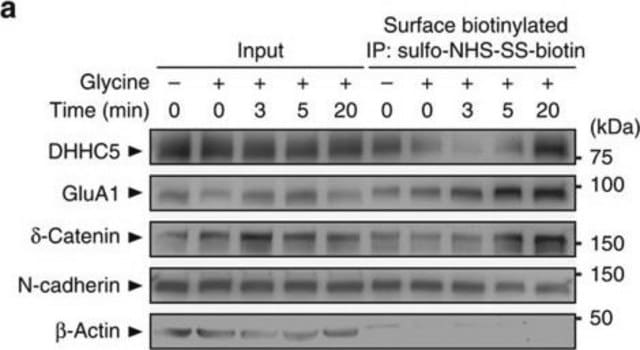MABN1573
Anti-Synapsin-2 Antibody, clone 19.4
clone 19.4, from mouse
Sinónimos:
Synapsin II, Synapsin-2
About This Item
Productos recomendados
origen biológico
mouse
Nivel de calidad
forma del anticuerpo
purified immunoglobulin
tipo de anticuerpo
primary antibodies
clon
19.4, monoclonal
reactividad de especies
rat, mouse, human
técnicas
activity assay: suitable
immunohistochemistry: suitable (paraffin)
immunoprecipitation (IP): suitable
western blot: suitable
isotipo
IgG2aκ
Nº de acceso NCBI
Nº de acceso UniProt
Condiciones de envío
dry ice
modificación del objetivo postraduccional
unmodified
Información sobre el gen
human ... SYN2(6854)
Descripción general
Especificidad
Inmunógeno
Aplicación
Western Blotting Analysis: Target detection by a representative lot was blocked by a preincubation with phage particles displaying peptides containing the SYIxN consensus sequence (Vaccaro, P., et al. (1997). Brain Res. Mol. Brain Res. 52(1):1-16).
Western Blotting Analysis: A representative lot detected synapsin IIa/IIb, but not Ia/Ib, in rat brain cytosolic extracts (Vaccaro, P., et al. (1997). Brain Res. Mol. Brain Res. 52(1):1-16).
Immunoprecipitation Analysis: A representative lot immunoprecipitated synapsin IIa/IIb, but not Ia/Ib, from rat brain synaptosomal preparations (Vaccaro, P., et al. (1997). Brain Res. Mol. Brain Res. 52(1):1-16).
Enzyme Assay Analysis: A representative lot, when added 2 hours prior to cAMP, prevented PKA-catalyzed phosphorylation of synapsin IIa/IIb in an in vitro kinase assay using rat brain synaptosomal preparations (Vaccaro, P., et al. (1997). Brain Res. Mol. Brain Res. 52(1):1-16).
Neuroscience
Developmental Neuroscience
Calidad
Western Blotting Analysis: 0.5 µg/mL of this antibody detected Synapsin-2 in 10 µg of rat brain tissue lysate.
Descripción de destino
Forma física
Almacenamiento y estabilidad
Handling Recommendations: Upon receipt and prior to removing the cap, centrifuge the vial and gently mix the solution. Aliquot into microcentrifuge tubes and store at -20°C. Avoid repeated freeze/thaw cycles, which may damage IgG and affect product performance.
Otras notas
Cláusula de descargo de responsabilidad
¿No encuentra el producto adecuado?
Pruebe nuestro Herramienta de selección de productos.
Código de clase de almacenamiento
12 - Non Combustible Liquids
Clase de riesgo para el agua (WGK)
WGK 2
Punto de inflamabilidad (°F)
Not applicable
Punto de inflamabilidad (°C)
Not applicable
Certificados de análisis (COA)
Busque Certificados de análisis (COA) introduciendo el número de lote del producto. Los números de lote se encuentran en la etiqueta del producto después de las palabras «Lot» o «Batch»
¿Ya tiene este producto?
Encuentre la documentación para los productos que ha comprado recientemente en la Biblioteca de documentos.
Nuestro equipo de científicos tiene experiencia en todas las áreas de investigación: Ciencias de la vida, Ciencia de los materiales, Síntesis química, Cromatografía, Analítica y muchas otras.
Póngase en contacto con el Servicio técnico








